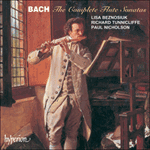The Sonata in B minor, BWV1030, together with the orchestral suite in the same key (BWV1067), is representative of Bach’s greatest contribution to the literature of the transverse flute. In an earlier form (c1729–1736) the work was written in G minor; but only the harpsichord part has survived, casting doubt over Bach’s choice of partnering instrument. Though sometimes played by an oboe in this version, there is no conclusive evidence to support its claim. The version in B minor for flute and obbligato harpsichord is preserved in an autograph dating from Bach’s middle Leipzig years (c1736). It is the most extended and most ambitious of all his flute sonatas, and striking for the freedom afforded the keyboard part in the thematically varied opening ‘Andante’. The contrapuntal texture is sustained throughout by Bach’s wonderfully imaginative technique while he further holds our interest through an intellectually disciplined organization of ideas. The ‘Largo e dolce’, in D major, is in the rhythm of a siciliano whose melody is almost entirely the preserve of the flute. From an expressive standpoint, the movement foreshadows the north German sensitive style cultivated by Bach’s elder sons, Wilhelm Friedemann and Carl Philipp Emanuel. The concluding movement is in two distinct sections, a fugue marked ‘Presto’ and a Gigue. This scheme, unusual in Bach’s music, provides not only additional variety but also confirms the virtuosity and profusion of ideas characteristic of the entire sonata.
from notes by Nicholas Anderson © 2002
Avec la suite orchestrale en si mineur (BWV1067), la Sonate en si mineur, BWV1030, est la plus remarquable contribution de Bach au répertoire de la flûte traversière. Elle nous est parvenue sous une forme plus ancienne (vers 1729–1736), en sol mineur, mais seule la partie de clavecin a survécu, laissant planer le doute sur l’identité du second instrument. Si cette première version est parfois interprétée au hautbois, rien ne permet d’affirmer que ce choix ait été celui de Bach. La version en si mineur pour flûte et clavecin obligé est préservée dans un autographe datant du milieu des années leipzigoises de Bach (vers 1736). C’est la plus développée et la plus ambitieuse de ses sonates pour flûte, et on y est frappé par la liberté accordée à la partie de clavecin dans l’«Andante» initial, thématiquement varié. Sa technique merveilleusement imaginative permet à Bach de maintenir tout au long une écriture contrapuntique, tout en sollicitant notre intérêt de bout en bout par une rigoureuse organisation des idées. Le «Largo e dolce», en ré majeur, est bâti sur un rythme de sicilienne, la mélodie étant presque exclusivement réservée à la flûte. D’un point de vue expressif, ce mouvement annonce le style sensible de l’Allemagne du Nord que cultiveront les fils aînés de Bach, Wilhelm Friedemann et Carl Philipp Emanuel. Le dernier mouvement est en deux sections distinctes: une fugue, marquée «Presto», et une gigue. Cette succession, inhabituelle chez Bach, contribue non seulement à la variété de l’œuvre mais confirme en outre la virtuosité et l’abondance des idées caractéristiques de cette sonate dans son intégralité.
extrait des notes rédigées par Nicholas Anderson © 2002
Français: Josée Bégaud
Die Sonate in h-Moll, BWV1030, kann gemeinsam mit der Orchestersuite in derselben Tonart als repräsentativ für Bachs größten Beitrag zur Querflötenliteratur gelten. In einer früheren Version (um 1729–1736) war dieses Werk in g-Moll verfasst; es blieb jedoch lediglich der Cembalopart erhalten, was Bachs Wahl des Partnerinstruments in Zweifel zieht. Obwohl der Part in dieser Version manchmal von einer Oboe übernommen wird, gibt es keinen schlüssigen Beweis für diese Vermutung. Die Version in h-Moll für Flöte und obligates Cembalo blieb in einer Handschrift aus Bachs mittleren Leipziger Jahren erhalten (ca.1736). Sie ist die ausgedehnteste und ehrgeizigste aller seiner Flötensonaten und beeindruckt durch die Freiheit, die dem Tastatur-Part in der thematisch wechselvollen Eröffnung gewährt wird. Die kontrapunktische Struktur wird mittels Bachs herrlich einfallsreicher Technik durch das gesamte Werk hindurch aufrechterhalten, und zugleich nimmt er unsere Aufmerksamkeit durch eine geistig disziplinierte Organisation von Ideen gefangen. Das „Largo e dolce“ in D-Dur hat den Rhythmus eines siciliano, dessen Melodie fast vollständig von der Flöte getragen wird. Vom Blickpunkt des Ausdrucks her deutet dieser Satz auf den norddeutschen empfindsamen Stil hin, wie er von Bachs älteren Söhnen Wilhelm Friedemann und Carl Philipp Emanuel kultiviert wurde. Der Schlusssatz ist in zwei klar abgegrenzte Abschnitte aufgeteilt: eine Fuge mit der Bezeichnung „Presto“ und eine Gigue. Dieses für Bachs Musik ungewöhnliche Schema liefert nicht nur zusätzliche Abwechslung, sondern bestätigt die Virtuosität und den Ideenreichtum, die für die gesamte Sonate charakteristisch sind.
aus dem Begleittext von Nicholas Anderson © 2002
Deutsch: Atlas Translations


 Bach: The Complete Flute Sonatas
Bach: The Complete Flute Sonatas
